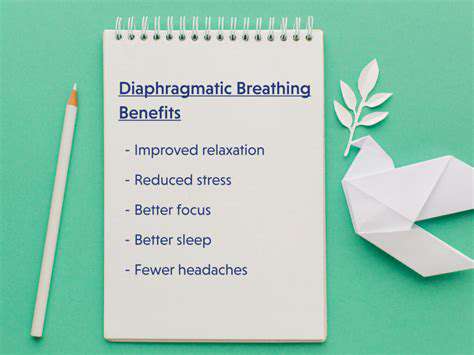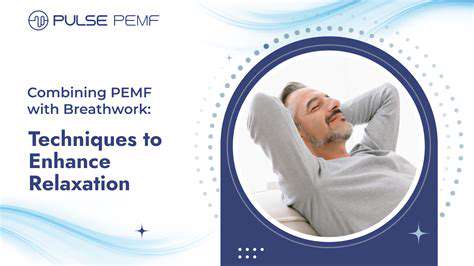Connecting Anxiety Symptoms to Deep Breathing Practices

Diaphragmatic Breathing Explained
Diaphragmatic breathing, also known as abdominal breathing, is a technique that utilizes the diaphragm muscle to maximize lung capacity. This process involves inhaling deeply, allowing the diaphragm to contract and move downward, thus expanding the lungs and drawing air into the body. By focusing on this type of breathing, individuals can improve their overall respiratory function and well-being, leading to a multitude of physical and mental health benefits.
The diaphragm is a crucial muscle located beneath the lungs. When you breathe in, it contracts, creating negative pressure within the chest cavity. This negative pressure draws air into the lungs. Proper diaphragmatic breathing ensures that the entire lung capacity is utilized, promoting more efficient oxygen intake and carbon dioxide expulsion.
Benefits of Diaphragmatic Breathing
Regular practice of diaphragmatic breathing can significantly improve both physical and mental well-being. It can alleviate stress and anxiety by calming the nervous system, promoting relaxation, and reducing feelings of panic.
The benefits extend beyond stress management. Diaphragmatic breathing can also improve sleep quality, reduce chronic pain, and enhance athletic performance by optimizing oxygen uptake.
Techniques for Diaphragmatic Breathing
Learning diaphragmatic breathing involves a few simple steps. First, find a comfortable position, either sitting or lying down. Place one hand on your chest and the other on your abdomen. Inhale slowly and deeply through your nose, allowing your abdomen to rise as your diaphragm expands. Feel the air filling your lungs. Exhale slowly and completely through your mouth, allowing your abdomen to fall as your diaphragm relaxes.
Practice focusing on the sensation of your abdomen rising and falling with each breath. This conscious awareness helps to anchor your attention on your breathing and foster a sense of calm and control.
Integrating Diaphragmatic Breathing into Daily Life
Integrating diaphragmatic breathing into your daily routine can significantly improve your overall health and well-being. Try incorporating short breathing exercises throughout the day, such as during breaks at work or before important meetings. These brief sessions can help to manage stress and anxiety and promote a sense of calm and focus.
By making diaphragmatic breathing a regular practice, you can cultivate a greater sense of awareness and control over your body and mind. This mindful approach can lead to improved physical health, enhanced emotional regulation, and an overall greater sense of well-being.
Practical Deep Breathing Exercises for Anxiety Relief
Understanding the Connection Between Breathing and Anxiety
Anxiety often manifests as a physical response, and shallow, rapid breathing is a common symptom. When we feel anxious, our bodies react as if facing a threat, triggering the fight-or-flight response. This response, while helpful in dangerous situations, can become problematic when triggered by everyday stressors. Rapid, shallow breathing exacerbates this response, leading to a vicious cycle of increased anxiety and further difficulty controlling breathing. Understanding this connection is the first step towards using deep breathing techniques to manage anxiety.
Deep breathing exercises work by stimulating the parasympathetic nervous system, the part of our nervous system responsible for the rest and digest response. By slowing down and deepening our breaths, we help to counteract the effects of the sympathetic nervous system's fight-or-flight response, calming the body and mind.
Diaphragmatic Breathing: The Foundation
Diaphragmatic breathing, also known as belly breathing, is a fundamental technique for anxiety relief. It involves focusing on the movement of your diaphragm, the muscle located beneath your lungs. When you breathe deeply, your diaphragm contracts, drawing air into your lungs. This type of breathing activates the parasympathetic nervous system more effectively than shallow chest breathing, promoting relaxation.
To practice, lie down or sit comfortably. Place one hand on your chest and the other on your stomach. Inhale slowly and deeply through your nose, feeling your stomach rise as your diaphragm expands. Exhale slowly through your mouth, allowing your stomach to fall. Repeat this process several times, focusing on the smooth, controlled rhythm of your breath.
Box Breathing: A Simple, Powerful Technique
Box breathing is a structured breathing pattern that can quickly calm the nervous system. It involves inhaling for a count of four, holding your breath for a count of four, exhaling for a count of four, and holding your breath again for a count of four. This rhythmic pattern helps to regulate your breath and create a sense of groundedness.
Practicing box breathing can be particularly helpful in moments of intense anxiety, providing a structured way to focus your attention on your breath and break the cycle of anxious thoughts.
Progressive Muscle Relaxation with Breathing
Combining progressive muscle relaxation with deep breathing can significantly enhance the relaxation response. Progressive muscle relaxation involves systematically tensing and releasing different muscle groups in your body. Each time you tense a muscle group, you take a deep breath in to prepare for releasing the tension. This process helps to release physical tension that can be contributing to anxiety.
Mindful Breathing for Stress Reduction
Mindful breathing is a practice that involves paying close attention to your breath without judgment. You simply observe the sensation of the air entering and leaving your body. This practice helps to anchor you in the present moment, reducing the tendency to dwell on anxious thoughts or worries about the future.
Regular practice of mindful breathing can cultivate a greater awareness of your body and mind, empowering you to recognize and manage anxiety symptoms more effectively.
Using Breathing Techniques in Daily Life
Incorporating deep breathing exercises into your daily routine can be invaluable for managing anxiety. Practicing these techniques throughout the day, whether during a stressful meeting, before an important presentation, or simply when you feel anxious, can help to establish a sense of calm and control. You can practice these techniques in various settings, from your home to your workplace, making them a flexible and accessible tool for anxiety relief.
Carry a small notebook or use a phone app to record your experiences with deep breathing exercises and observe how different techniques work for you in different situations. This allows you to track your progress and tailor your approach for optimal results.
Beyond Breathing: Combining Techniques for Enhanced Well-being

Beyond Breathing: Harnessing the Power of Mindful Movement
Mindful movement isn't just about stretching or yoga; it's about cultivating a deeper connection with your body in motion. By paying attention to the sensations of each movement, from the subtle stretch of a finger to the powerful swing of an arm, we can develop a heightened awareness of our physical selves. This awareness extends beyond the physical, influencing our emotional and mental states as well.
Integrating mindful movement into your daily routine can foster a sense of calm and stability. It allows us to become more attuned to our body's needs, leading to a more balanced and harmonious existence.
Exploring the Synergy of Breath and Body
The breath is the invisible thread that connects our mind, body, and spirit. By consciously engaging with our breath while moving, we create a powerful synergy. This synergy allows us to navigate the complexities of daily life with greater ease and resilience.
This integration of breath and movement can help to reduce stress and anxiety, promoting a sense of calm and well-being. It is a powerful tool for self-regulation, allowing us to respond rather than react to the challenges life throws our way.
The Impact of Technology on Physical Practice
The modern world is brimming with technology, and this technology can be a powerful tool for enhancing mindful movement practices. From fitness trackers to guided meditation apps, numerous digital resources are available to assist us in connecting with our bodies more deeply and effectively.
These tools offer personalized feedback, encouraging progress and inspiring sustained practice. However, it's crucial to strike a balance, ensuring technology complements rather than replaces the inherent value of mindful connection.
Cultivating Mindfulness in Everyday Activities
Mindfulness isn't confined to dedicated practice sessions; it can be woven into the fabric of our everyday lives. Simple activities like walking, eating, or even washing dishes can become opportunities for mindful engagement.
By paying attention to the sensations and details of these activities, we cultivate a greater appreciation for the present moment.
This consistent practice of mindfulness can empower us to transform seemingly mundane moments into opportunities for self-discovery and personal growth.
The Role of Intention in Movement
Intention plays a crucial role in shaping our experience of mindful movement. When we approach movement with a clear intention, whether it's to release tension, increase flexibility, or simply connect with our inner selves, we unlock a deeper level of awareness and engagement.
This intentional approach brings a sense of purpose and direction to our movement, making it more meaningful and impactful.
The Importance of Consistency and Patience
Developing a mindful movement practice is a journey, not a destination. Consistency and patience are essential for cultivating a lasting connection with our bodies and minds. It's important to understand that progress takes time and effort, and to avoid getting discouraged by setbacks.
Embracing the process, celebrating small victories, and maintaining a supportive mindset are crucial for long-term success.
Beyond Physical Benefits: Emotional and Mental Well-being
Mindful movement offers a wealth of benefits that extend far beyond the physical realm. It can significantly impact our emotional and mental well-being, helping us to manage stress, anxiety, and depression.
By cultivating a deeper connection with our bodies, we gain a greater sense of self-awareness and emotional regulation. This inner peace, in turn, strengthens our overall well-being, allowing us to navigate life's challenges with greater resilience and grace.